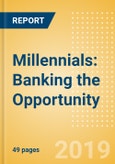Millennials: Banking the Opportunity
Summary
Also known as Generation Y, millennials are distinct from the surrounding generations based on their unique formative experiences, which include pronounced technological, economic, and social shifts. In the last two decades, millennials have matured in terms of their size, economic strength, and socio-cultural influence.
Many millennials are well into their careers and are ready to invest and use financial advice. Their current and imminent financial commitments - such as paying off tertiary education, and buying their first house or car - will fuel growth in the banking sector for the foreseeable future.
Understanding their lifestyles, goals, and behavior is key given their status as a fast-rising financial services market. The industry must respond with relevant strategies that leverage the shifts in banking behavior and seize the maturing opportunity.
The report "Millennials: Banking the Opportunity", explores the attitudes and behaviors millennials have with regards to their financial services products. It explores the major factors shaping their lifestyles and goals, and what this means for the financial services industry. Products covered in the report range from everyday current accounts to all forms of credit to investments.
Scope
Reasons to Buy
Summary
Also known as Generation Y, millennials are distinct from the surrounding generations based on their unique formative experiences, which include pronounced technological, economic, and social shifts. In the last two decades, millennials have matured in terms of their size, economic strength, and socio-cultural influence.
Many millennials are well into their careers and are ready to invest and use financial advice. Their current and imminent financial commitments - such as paying off tertiary education, and buying their first house or car - will fuel growth in the banking sector for the foreseeable future.
Understanding their lifestyles, goals, and behavior is key given their status as a fast-rising financial services market. The industry must respond with relevant strategies that leverage the shifts in banking behavior and seize the maturing opportunity.
The report "Millennials: Banking the Opportunity", explores the attitudes and behaviors millennials have with regards to their financial services products. It explores the major factors shaping their lifestyles and goals, and what this means for the financial services industry. Products covered in the report range from everyday current accounts to all forms of credit to investments.
Scope
- Millennial penetration over-indexes in 14 of 21 financial holdings. This underscores the importance of targeting these consumers with products they value delivered in ways they prefer.
- Millennials are more likely to experience a number of key life events in the coming years. Banks can capitalize on this with targeted products designed to facilitate these events or mitigate the disruption they cause.
- Millennials still make safe and conformist choices about where to bank. They express moderate satisfaction with their product holdings, but there is a real interest in new (particularly digital) product features.
Reasons to Buy
- Gain insight into the purchasing path of millennial consumers.
- Identify which financial products have already gained traction with the millennial segment and which are potential growth markets.
- Assess which attitudes and behaviors of millennials truly set them apart from older segments, and which are merely the result of their younger age.
Table of Contents
1. EXECUTIVE SUMMARY
2. MILLENNIALS ARE A KEY AUDIENCE FOR RETAIL BANKING
3. MILLENNIAL ATTITUDES AND ACTIONS WARRANT SPECIAL FOCUS
4. APPENDIX
List of Figures
Companies Mentioned (Partial List)
A selection of companies mentioned in this report includes, but is not limited to:
- Visa
- Mastercard
- Commonwealth Bank of Australia
- OCBC
- Bank of Montreal








